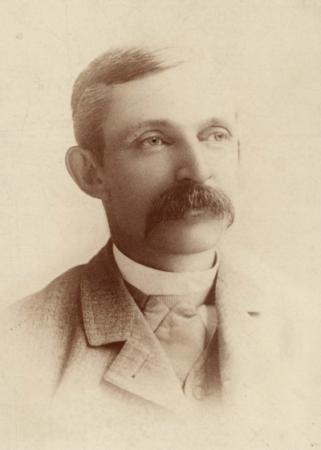James K. P. Miller
James K. P. Miller
April 6, 1845 - January 12, 1891
Although James K. P. Miller lived in Deadwood for only 15 years, he had a significant impact on the community. Born in upstate New York, James briefly worked as a manager at an oil refinery in Buffalo before striking out west. By the time he was 20, James was clerking for various grocers in Montana boomtowns. He soon worked his way up, coming to own his own store by 1871.
But by 1876, James had come east to Minneapolis, where he and his partner James McPherson loaded up eight wagons full of groceries and general merchandise and headed for Deadwood. They worked as wholesalers, offering their wares to the nearly 200 merchants who had shops in Deadwood Gulch. Sales were so successful that the pair quickly arranged for 23 additional wagon loads of supplies.
Miller and McPherson purchased a lot at the corner of Main and Wall Streets and established a retail and wholesale grocery, along with a bank that specialized in handling gold dust. The fire of 1879 devastated their business, and McPherson left town. Miller, however, stayed, reopening a grocery store the following year. It grew so quickly that an 1883 newspaper story reported he received more freight in one year than all the merchants of Rapid City combined. James used his success to open branch stores in other Black Hills mining towns and invested in local real estate. Miller was elected to the Deadwood city council in 1884.
Aware that the initial gold rush had faded, James felt that Deadwood’s economy needed to be reinvigorated, and he joined Seth Bullock in organizing the Board of Trade in 1881. Miller helped establish a flour mill and advocated for a new hotel, but his real focus was on getting a railroad into town. He took a leading role in courting the Freemont, Elkhorn & Missouri Valley Railroad, which was building a line up the east side of the Black Hills in 1885. Although reluctant at first, the FE&MV Railroad eventually was lured into a competitive race with the Burlington & Missouri River Railroad, thanks to a series of backroom deals and land transfers James orchestrated. Both railroads connected to Deadwood within just a few weeks of each other in late 1890 and early 1891.
In anticipation of the rail connection, James formed an investment group called the Syndicate. One of the group’s first projects was a substantial downtown commercial building, completed in 1888, which became known as the Syndicate Block. Recognizing that all progressive cities had street railways, James helped organize and build the Deadwood Street Railway in 1888 and the interurban rail line to Lead in 1889. These projects led one newspaper article to name him the "Savior of Deadwood."
James was ill for much of 1890, even while attending city council meetings and leading projects. Late that year, his doctor recommended he rest and recover in California. He died in Santa Barbara in early 1891 at the age of 45. Upon his death, the Black Hills Daily Times opined that his "name will always be coupled with the prosperity of Deadwood and the Black Hills."

